Advertisement
Spotlight Stories Archive
Empowering the Forgotten Workforce
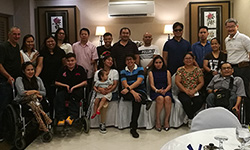 For many individuals, retirement means stepping away from corporate life. Not so for Thomas Ng, who enjoyed an illustrious 25-year career as an international corporate executive. After retiring as president and country manager for ABB in the Philippines, he launched Genashtim, an online global eLearning and support services company. A primary focus of the for-profit social enterprise is to employ and empower what Thomas calls “the forgotten workforce”.
For many individuals, retirement means stepping away from corporate life. Not so for Thomas Ng, who enjoyed an illustrious 25-year career as an international corporate executive. After retiring as president and country manager for ABB in the Philippines, he launched Genashtim, an online global eLearning and support services company. A primary focus of the for-profit social enterprise is to employ and empower what Thomas calls “the forgotten workforce”.
“My company was set up to leverage technology and the internet to provide gainful, sustainable, and dignified employment for the marginalized communities all over the world,” Thomas explains in a YouTube video. “[I] wanted to do something for the people that the corporate world had left behind.”
Almost 70 percent of Genashtim’s 100-person staff has a disability, and 25 percent are refugees. All are able to work remotely from the comfort, safety, and convenience of their homes because Genashtim is a cloud-based company with no physical office or operations center.
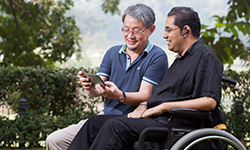 Genashtim employees serve clients around the world. “Most of our customers are not even aware of the social impact aspects of our company,” Thomas notes. His vision is to give differently-abled and marginalized people the opportunity to unleash their potential by joining the workforce and contributing to society. The company slogan is: Empowering people, enabling business.
Genashtim employees serve clients around the world. “Most of our customers are not even aware of the social impact aspects of our company,” Thomas notes. His vision is to give differently-abled and marginalized people the opportunity to unleash their potential by joining the workforce and contributing to society. The company slogan is: Empowering people, enabling business.
Prior to founding Genashtim, Thomas served on the boards of several NGOs, advocating for the gainful employment of persons with disabilities. A popular speaker and activist, he is one of UNESCAP's seven "promoters" for the new Asia and Pacific Decade of Persons with Disabilities, 2013-2022.
As Genashtim grows, Thomas is committed to hiring members from other marginalized communities—such as lepers, ex-convicts, the HIV-infected, and women in oppressed environments. He firmly believes that empowering “the forgotten workforce” transforms their lives and is good for business.
A bonus is that Genashtim’s business model is also good for the environment. With the entire workforce being online and remote, Genashtim is a green company that is doing its part to lower emissions and congestion in the cities. The company proudly holds B Corp certification, which means it meets rigorous standards of social and environmental performance, accountability, and transparency.
Buddy Cruise: A Cruise for All Ages and Abilities
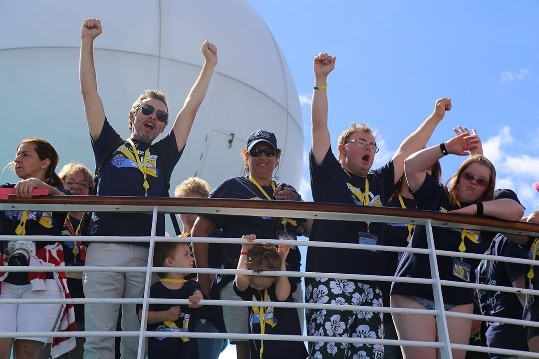 Every year Jorge Arnoldson (manager of application development at eLogic Learning) and his wife, Pamela, run a group cruise. But it's not just any ordinary cruise—Buddy Cruise is a non-profit dedicated to resources and advocacy for individuals with special needs and their families.
Every year Jorge Arnoldson (manager of application development at eLogic Learning) and his wife, Pamela, run a group cruise. But it's not just any ordinary cruise—Buddy Cruise is a non-profit dedicated to resources and advocacy for individuals with special needs and their families.
The cruise features a conference, workshop, events, exclusive excursions, and activities for families to make memories in an inclusive environment. It can be a life-changing experience for individuals with special needs and their families to take a vacation in a place where everyone "fits in," and where they have the opportunity to learn from each other and make connections.
Many milestones—such as talking and even taking first steps—occur on the cruise, and participants master independent living skills. The joy and excitement spreads to everyone who interacts with the group. Even people who don't have loved ones with special needs book with the group because they like being in such a positive environment.
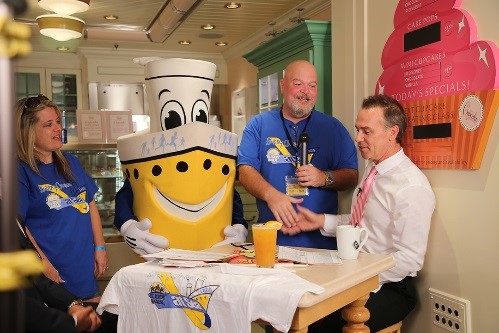 “They just want to be a part of the excitement and joy that Buddy Cruise exudes. That's great awareness,” Pamela said. Even the crew sheds a few tears when the families disembark.
“They just want to be a part of the excitement and joy that Buddy Cruise exudes. That's great awareness,” Pamela said. Even the crew sheds a few tears when the families disembark.
Buddy Cruise launched in 2007 with a group of 87 people. Today, more than 500 participate. As the event has grown, so has the workload. Jorge and Pamela volunteer much of their time doing fundraising, scheduling, making phone calls, doing paperwork, emailing, and more—often working nights and weekends.
“Buddy is funded by donations and fundraisers, and every cent goes back into the programs,” says Pamela. “Maybe one day we will find a grant or have funding for salary," she adds.
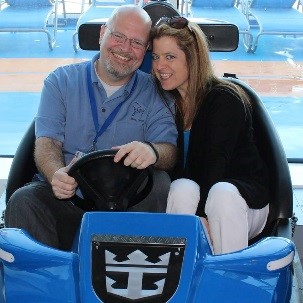 In addition to the actual cruise, the organization has several outreach programs. These include an ambassador program, classroom reach-out, and donating supplies and equipment to organizations serving individuals with special needs.
In addition to the actual cruise, the organization has several outreach programs. These include an ambassador program, classroom reach-out, and donating supplies and equipment to organizations serving individuals with special needs.
The Arnoldsons were motivated to start Buddy Cruise because their youngest child has Down syndrome. After attending a national walk for Down syndrome awareness, they noticed how important it was for their son to be part of a community. Their other children, however, were not fans of walking and joked that they would rather go on a cruise.
The idea slowly unfolded and today, 12 Buddy Cruises later, they take to the seas each year with hundreds of participants. As Pamela notes, “There is something magical that happens when you get all of these ‘kids’ together.”
Seeing Through Sound
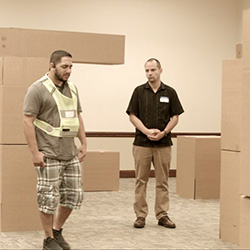 When Google created an incubator project to find ways to use its Tango augmented reality platform, Chad Udell and his team at Float started brainstorming ideas. “A lot of companies were proposing games. And as much as we all love games, we wanted to find something that might have a more meaningful impact on someone’s life,” Chad explains. One of his team members thought about his own sister who was visually impaired and wondered if this technology could help her navigate obstacles more easily. From this idea, Cydalion was born.
When Google created an incubator project to find ways to use its Tango augmented reality platform, Chad Udell and his team at Float started brainstorming ideas. “A lot of companies were proposing games. And as much as we all love games, we wanted to find something that might have a more meaningful impact on someone’s life,” Chad explains. One of his team members thought about his own sister who was visually impaired and wondered if this technology could help her navigate obstacles more easily. From this idea, Cydalion was born.
Named after the Greek mythology figure Cedalion, who guided Orion when he became blind, Cydalion was designed to help with higher obstacles that a cane or guide dog might not detect, such as a light fixture or shelf. Their research told them that one in four individuals with visual impairments suffer a head or neck injury of some sort at least once a month.
With Cydalion, users place the Tango device in a pouch in their clothing or in a lanyard around their neck, and then they receive sounds and other alerts through a set of bone-conduction headphones. In a way, it's a bit like sonar.
Chad and his team worked with Google and with accessibility experts and users at Illinois State University to refine the design and ended up with users all over the world. Unfortunately, Google discontinued the Tango technology but many of the design concepts found their way into future devices and software tools.
“I do wish the product had lasted longer,” Chad says. “But even so, it was such a valuable experience and gave us so much insight about building inclusivity into all of our designs.” Chad encourages all of us to do the same. “As learning professionals, we have an obligation to be inclusive. So much of the technology we work with in our community has accessibility features. It’s up to us to make sure we read the specifications and do what we can to create solutions that everyone can use.”
And if you want to do more, Chad encourages you to reach out to organizations that serve individuals with disabilities. Many national charities help at a systemic level, “but if you want to make a real difference in an individual person’s life,” Chad says, “find a local organization that has boots on the ground.” Local groups, for example, might have the ability to help an individual who is blind get a screen reader or other assistive technology.
A Simple Idea That Electrifies a Community
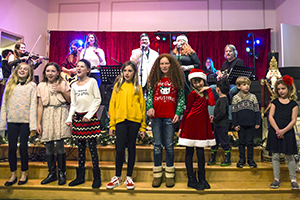 What comes to mind when you think of the holidays? For me, it’s gathering with friends and family to create lasting memories, baking sweet treats to share with all, and singing holiday classics. What if you could turn all of those warm-hearted blessings into support for the local homeless population? That’s exactly what my friend and colleague, Mike Sloat, and his family decided to do three years ago.
What comes to mind when you think of the holidays? For me, it’s gathering with friends and family to create lasting memories, baking sweet treats to share with all, and singing holiday classics. What if you could turn all of those warm-hearted blessings into support for the local homeless population? That’s exactly what my friend and colleague, Mike Sloat, and his family decided to do three years ago.
Mike regularly shares his creative talents as the official videographer at Learning Guild events, but his artistic side crosses over into the music world, as well. So it was no surprise when he decided to leverage his love of music and create a new holiday tradition in 2015. The tradition began as a small way for his family to rediscover the true spirit of the holidays by giving back. It has transformed into a magical community event that has seen steady growth.
The energy and buzz in the first of two sold-out concerts was infectious! You couldn’t help but sing along with more than 50 musicians who spent countless hours rehearsing, in addition to drumming up raffle prizes and baking yummy vittles for all to enjoy. This community project was a true labor of love that you could see and feel amongst everyone in the room who came out to enjoy it. From the exuberant sing-a-long section—with such favorites as Jingles Bells, Rudolph the Red-Nosed Reindeer, and We Wish You a Merry Christmas—to a rendition of The Grinch that brought the house down, this was a holiday event-turned-community-tradition not to be missed.
What has been truly inspiring are the donations collected for those less fortunate. With close to 3,000 homeless in Sonoma County, California—ranging from small children to veterans and even those affected by the recent California wildfires—there is a dire need for services and supplies to support the homeless community. The Sloat family recognized this and jumped to action. Over the last three years they’ve worked with the Redwood Gospel Mission to provide monetary donations. These donations have supported a dorm-improvement project, as well as a major kitchen renovation to undertake their Black Coat & Catering Certification program. In addition, this year they also collected bags upon bags of new or gently-used winter coats, new socks, and packaged food for distribution directly to the homeless through the Redwood Empire Food Bank.
A close friend of Mike’s summed it up best, saying, “This is my favorite Christmas event! Thank you for giving back to the community. I’m happy to be a part of it.”
Drawing For Dialysis
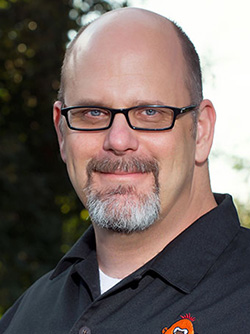 I’ve known Kevin Thorn for more than 10 years. I am not alone in finding him to be one of the most helpful, generous people I’ve ever met. When it comes to his time, Kevin is always willing to help, teach, share, or lend a hand to make sure the job gets done; someone gets the help they need; or a charity project gets funded.
I’ve known Kevin Thorn for more than 10 years. I am not alone in finding him to be one of the most helpful, generous people I’ve ever met. When it comes to his time, Kevin is always willing to help, teach, share, or lend a hand to make sure the job gets done; someone gets the help they need; or a charity project gets funded.
For the last five years, Kevin has been giving his time to a local children’s hospital. What started as an invitation to play Pictionary via closed-circuit television (CCTV) so sick children could watch from their beds has turned into so much more. That event led to interactive sessions called DoodleMania, where children could come to a room and join in continuous, interactive doodling. Another event involved a superhero day with multiple artists creating caricatures and other drawings with and for the children.
Kevin learned that although the hospital had a robust volunteer program with many opportunities to help, it did not have an official arts program. One of the child life supervisors suggested drawing with children during their dialysis treatments when they are tied to a machine with no access to CCTV. Kevin worked with volunteer coordinators to establish an official program for artists to teach and draw with the children.
Today when he visits the hospital, he brings a backpack full of crayons, markers, colored pencils, and paper, along with his iPad Pro. While one girl paints on the iPad, other children are drawing patterns, coloring mosaics, or learning about symmetry drawing. Another child is fascinated with lettering. Kevin enjoys sitting with them bedside and keeping their minds off the medical task at hand.
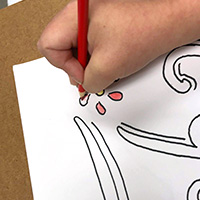
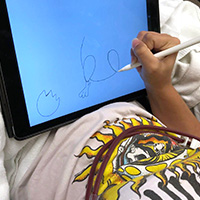
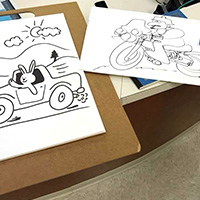
“All these kids are on transplant lists. I have a little bit of heartache when they move on, but I know it’s good that they moved on because they probably got a transplant,” he says. Kevin recently learned about the Draw for Help organization, which will ship a box directly to a hospital so supplies are on hand when the artists show up.
Kevin’s advice for all of us is simple: Don’t think about it. Just go do it.
“In any city that has a children’s hospital, you have no idea what these kids and their families are going through,” Kevin says. “But they love having something to do while they’re there to take their mind off the reason they are there. It also relieves the parent(s) for a bit of time, and gives them a break, as well,” he adds.
Kevin loves creating, drawing, and teaching. He is an inspiration to those around him—especially to the kids who get to draw and design, and whose eyes light up when they learn something new.
Intersecting Worlds: eLearning and Wildlife Rehab
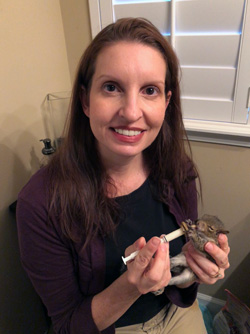 It’s 2:00 AM, and Desiree Pinder has to get up for yet another feeding. She works from home, so she can work (and sleep) on a flexible schedule to accommodate the feedings and doctor’s appointments. She walks over to the incubator and pulls the little one out for the first of eight feedings that day. This latest “pinky” came to her after a big storm rolled through St. Augustine, Florida, where she lives. He was found the next day, having fallen from his nest in a tree.
It’s 2:00 AM, and Desiree Pinder has to get up for yet another feeding. She works from home, so she can work (and sleep) on a flexible schedule to accommodate the feedings and doctor’s appointments. She walks over to the incubator and pulls the little one out for the first of eight feedings that day. This latest “pinky” came to her after a big storm rolled through St. Augustine, Florida, where she lives. He was found the next day, having fallen from his nest in a tree.
You see, Desiree is a certified wildlife rehabber. When she isn’t working as co-owner of Artisan E-Learning and XP Learning, she’s running Hotel for Squirrels. The pinky she’s feeding (a pinky is a squirrel so young it doesn’t have its hair yet) needs round-the-clock care. But with the right food, warmth, and gradual re-introduction into the outdoors, he’ll hopefully be released into the wild in about three months.
Since Desiree started rehabbing in 2016, she’s helped 50 squirrels (including a flying squirrel) and eight raccoons, and currently has a family of six ‘possums.
“It all started when a friend found a squirrel. I offered to take him and find out who to turn him over to. When I couldn’t find anyone, I started doing research myself and figured out what to do. That’s what got me hooked.” She then spent the next two years getting the training and certification she needed to do it properly.
So how does she manage all those babies along with a full-time job doing eLearning design and development? “Sometimes it’s tough to juggle both, and I couldn’t do it if I didn’t work for a virtual company” she says. “When I’m on internal video calls, my co-workers sometimes encourage me to do a feeding while we are talking—they enjoy seeing the little ones getting nursed back to health.”
And what if you’re ever on a video call with Desiree? “Normally I’d put them away for a client call. But if you really want to see one, just ask!”
